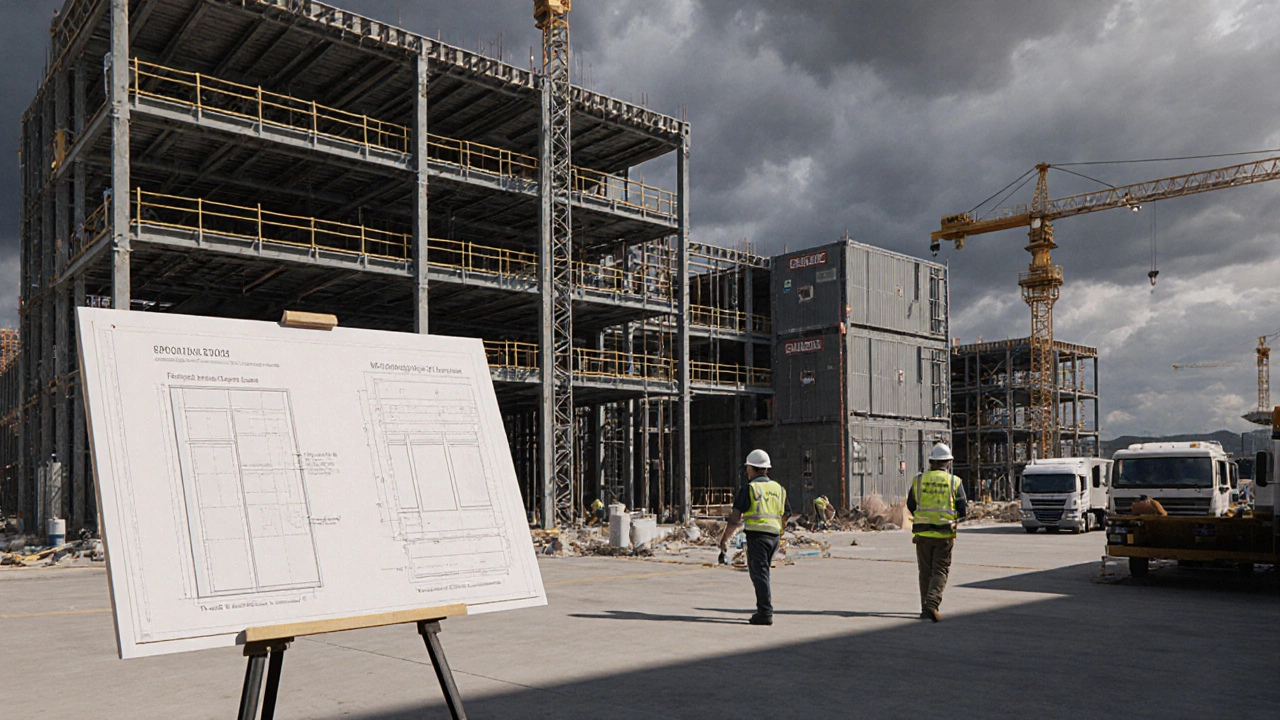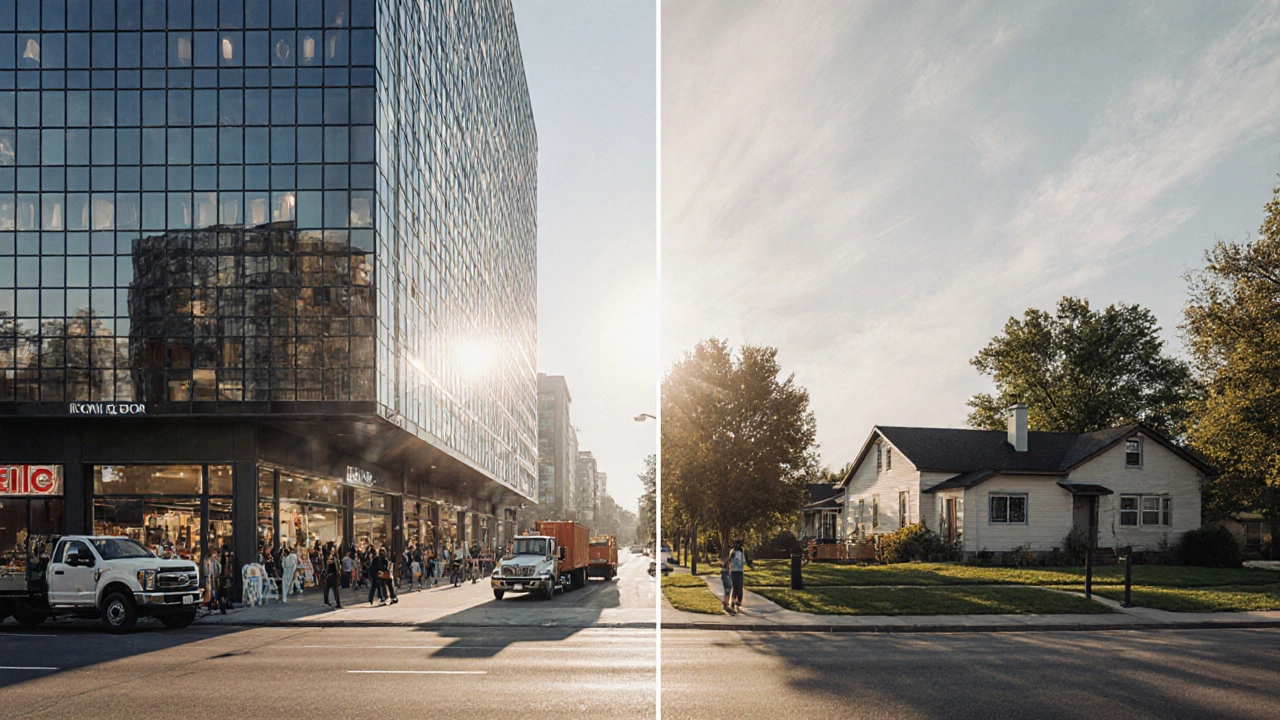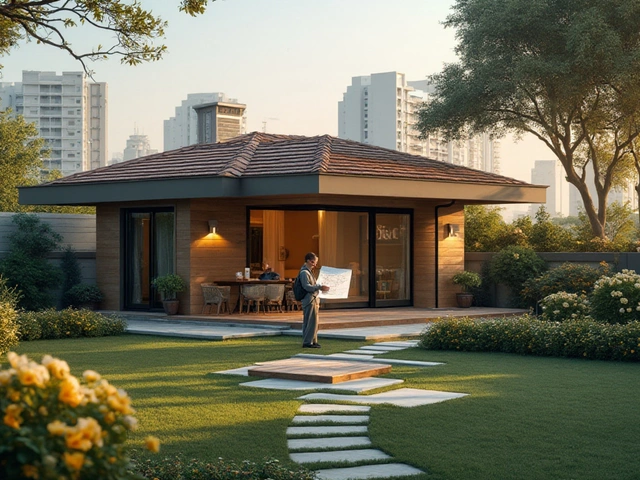Commercial construction vs non commercial: Key differences explained
Commercial Construction Assessment Tool
Answer these questions to determine your project type
Your Project Assessment
When you hear the term commercial construction is a type of construction focused on buildings intended for business use, such as offices, retail spaces, and warehouses. By contrast, non‑commercial construction refers to projects that serve personal, community, or public functions like homes, schools, or hospitals. Understanding the gap between these two worlds is essential for anyone planning a build, securing financing, or hiring a contractor.
Quick Takeaways
- Commercial projects prioritize revenue generation, durability, and compliance with stricter codes.
- Non‑commercial builds focus on livability, flexibility, and often have simpler financing.
- Regulatory hurdles, design standards, and stakeholder structures differ markedly.
- Choosing the right path starts with matching purpose, budget, and risk tolerance.
What is Commercial Construction?
Commercial construction covers any building where the primary revenue source comes from business activities. Typical examples include office towers, shopping centres, industrial warehouses, hotels, and mixed‑use developments. Because the end‑user is a business, the project usually involves:
- Higher financing needs, often through commercial loans or institutional investors.
- Stringent building code requirements, such as fire‑rated assemblies, ADA compliance, and energy‑performance targets.
- Complex zoning regulations that dictate floor‑area ratios, setbacks, and permissible uses.
- Extended project timelines to accommodate design‑build cycles, permitting, and tenant‑fit‑out phases.
What is Non‑Commercial Construction?
Non‑commercial construction encompasses projects that do not directly generate business revenue. This group includes residential homes, private schools, community centres, and public infrastructure like libraries or parks. The key characteristics are:
- Financing that often comes from personal mortgages, government grants, or charitable donations.
- Building codes that focus on safety and habitability, which are generally less demanding than those for high‑rise offices.
- Zoning that permits lower density and mixed residential‑community uses.
- Shorter design cycles because owners typically make fewer design changes after the permit stage.
Side‑by‑Side Comparison
| Aspect | Commercial | Non‑Commercial |
|---|---|---|
| Primary Purpose | Generate business income | Provide shelter, education, or public service |
| Typical Stakeholders | Developers, investors, tenants, property managers | Homeowners, NGOs, local authorities, school boards |
| Financing Sources | Commercial loans, equity partners, REITs | Mortgage lenders, government subsidies, personal savings |
| Regulatory Burden | Strict fire, accessibility, energy, and seismic codes | Standard residential or public‑use codes |
| Design Flexibility | Often limited by tenant fit‑out specifications and lease terms | Higher flexibility for owner‑driven changes |
| Project Timeline | 12‑36 months, sometimes longer for skyscrapers | 6‑18 months for typical homes or schools |
| Risk Profile | Higher financial risk, market‑demand sensitivity | Lower financial risk, personal or community impact focus |

Why Regulations Matter More in Commercial Projects
Commercial buildings often house many people, expensive equipment, and high‑value inventory. To protect life and investment, authorities enforce stricter building code provisions. For example, a 10‑story office must meet fire‑resistance ratings of 2‑hour assemblies, while a single‑family home typically needs only a 1‑hour rating.
Additionally, commercial properties must comply with the Americans with Disabilities Act (ADA) (or UK Equality Act equivalents). This shapes everything from doorway widths to restroom layouts, adding both design and cost considerations.
Financing Differences Explained
Commercial developers usually secure loans based on projected cash flow, lease agreements, and tenant creditworthiness. Lenders scrutinize the lease agreement terms, often requiring a minimum of 70‑80% pre‑lease to qualify.
Non‑commercial owners, on the other hand, rely on personal credit scores, down‑payment capacity, and sometimes government‑backed schemes such as the UK Help to Buy program. The risk assessment is simpler because the loan is tied to the individual's ability to repay rather than future rental income.
Design Standards and Aesthetic Goals
In commercial construction, design standards are driven by brand identity, tenant requirements, and efficiency metrics. A retail store might demand high ceilings and modular walls for rapid re‑merchandising, while a data centre needs raised floors and redundant power systems.
Non‑commercial projects prioritize comfort, energy efficiency, and personal taste. A family home may feature open‑plan living spaces, while a school focuses on durable finishes and safe circulation paths.
Stakeholder Structure: Who’s Involved?
Commercial builds bring together a longer list of players:
- Developers who own the land and drive the concept.
- Investors providing capital in exchange for equity.
- Tenants who sign long‑term leases.
- Property managers handling day‑to‑day operations.
- Contractors and subcontractors executing the build.
In non‑commercial projects, the list shrinks to the owner (or owner‑representative), a design‑build team, a lender, and possibly a local authority if public funding is involved.

Choosing the Right Path for Your Project
Before you label a job as “commercial” or “non‑commercial,” ask yourself these questions:
- What is the primary purpose of the building? Income‑generating or personal use?
- Do you have access to commercial financing or will you rely on personal funds?
- Are you prepared for stricter permits, inspections, and code compliance?
- Will the project involve multiple stakeholders with competing interests?
- What is your risk tolerance regarding market fluctuations?
Answering honestly will guide you toward the appropriate budgeting, design, and legal approach.
Common Misconceptions
Misconception 1: All large buildings are commercial.
Reality: A high‑rise residential tower is still non‑commercial if its units are sold or rented to private households.
Misconception 2: Commercial projects are always more expensive.
Reality: Some boutique retail spaces can cost less than a luxury home due to land value and finishes.
Misconception 3: Non‑commercial projects never need professional contractors.
Reality: Even a simple home addition benefits from a licensed contractor to meet code and ensure safety.
Checklist: Is Your Project Commercial?
- Revenue is expected from the building’s operation.
- Funding comes from commercial loans or investors.
- Design includes tenant‑specific fit‑outs.
- Regulatory package involves fire, accessibility, and energy codes beyond residential standards.
- Stakeholder map includes developers, investors, and property managers.
Bottom Line
Understanding the distinction between commercial and non‑commercial construction helps you set realistic budgets, select the right professionals, and avoid costly compliance surprises. Whether you’re eyeing a new office block or building your dream home, the choice shapes every step from financing to the final inspection.
Can a mixed‑use building be both commercial and non‑commercial?
Yes. Mixed‑use projects combine commercial space (like shops or offices) with residential units. Each portion follows its own code set, financing rules, and stakeholder requirements.
Do commercial construction loans require a higher down payment?
Typically, lenders ask for 20‑30% equity because the loan is tied to future rental income rather than personal credit. Residential mortgages can start at 5‑10% down.
What are the biggest code differences?
Commercial projects often need fire‑rated walls, sprinkler systems, higher load‑bearing floor designs, and ADA‑compliant routes. Residential codes focus on bedrooms, egress windows, and basic safety features.
How does project timeline differ?
Because of more permits, larger crews, and tenant fit‑outs, commercial builds often exceed 12 months. A typical home or school can complete in 6‑18 months.
Is insurance more costly for commercial projects?
Yes. Commercial policies cover higher liability limits, equipment loss, and business interruption, driving up premiums compared to standard homeowner policies.







Comments